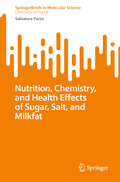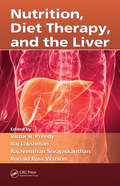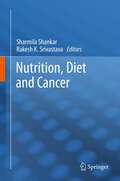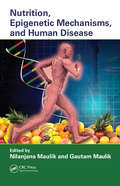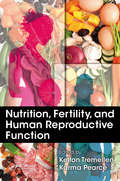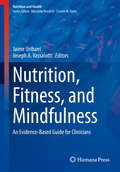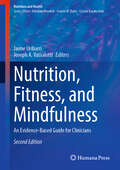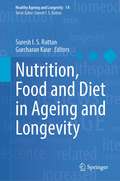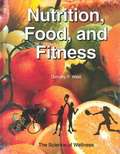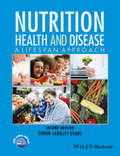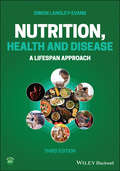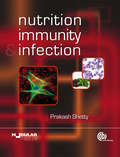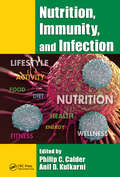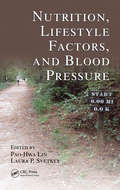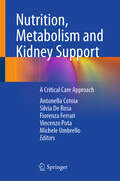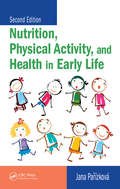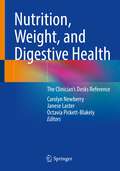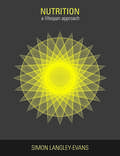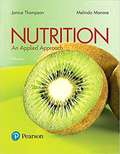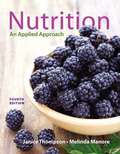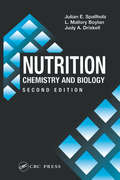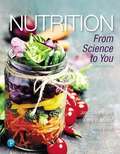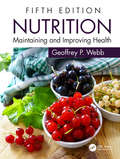- Table View
- List View
Nutrition, Chemistry, and Health Effects of Sugar, Salt, and Milkfat (SpringerBriefs in Molecular Science)
by Salvatore ParisiThis book covers sugar, salt and milk fat from a chemical perspective, and presents an overview of the role of these ingredients in our food, focusing on their flavors, satiety-inducing properties, nutritional impact, and health effects. The book begins with a chapter devoted to the chemical composition of these taste enhancers and satiety-inducing components, followed by a chapter that sheds light on the persuasive tactics employed by the food industry and their impact on consumer behavior, ultimately discussing the complex relationship between marketing strategies and public health. In Chapter 3, the author presents case studies and explores the nutritional requirements of these ingredients, while considering their physiological effects ad potential implications for human health. In Chapter 4, the author evaluates current consumption patterns and their implications, analyzing trends, policies, and opportunities to shape healthier dietary choices. The book closes with a chapter devoted to the effects of glucose, sodium and cholesterol deficiency, where the author discusses the consequences of imbalanced intake or deficiencies in these ingredients and outlines their impact on human health as well as evidence-based recommendations for keeping a balanced diet. Researchers, scholars, and students in the fields of food science, nutrition, chemistry will understand the appeal of this book.
Nutrition, Diet Therapy, and the Liver
by Victor R. Preedy Ronald Ross Watson Rajaventhan Srirajaskanthan Raj LakshmanWell-illustrated throughout and with in-depth analyses, Nutrition, Diet Therapy, and the Liver provides a holistic understanding of the causative elements that precipitate liver disease and the nutritional factors and regimens that reverse deteriorating hepatic function. This up-to-date resource also incorporates emerging fields of science and sign
Nutrition, Diet and Cancer
by Rakesh K. Srivastava Sharmila ShankarChemoprevention of cancer has been the focus of intensive research for more than two decades. Epidemiological evidence has shown a small, but significant association between fruit and vegetable intake and a reduction in cancer risk. Diet may account for about thirty five percent of cancer. Large claims have been made for the effectiveness of particular diets in determining one's risk of developing cancer, ranging from protection against cancer initiation, progression and metastasis. A wide array of dietary components has been demonstrated to be as effective in fighting off cancer. Towards an increased understanding of the nutrition, excercise and diet in preventing cancer or inhibiting its progression has led to the discovery and development of novel and effective drugs that regulate intracellular signaling network in the body. This information will be very useful to explore novel and highly effective chemopreventive strategies for reducing the health burden of cancer. Hippocrates, who proclaimed 25 centuries ago, 'Let food be thy medicine and medicine be thy food'. They estimated that one third of all cancer cases could be prevented by a healthier diet; statements which are widely accepted in the scientific literature. This book covers the current state-of-the art knowledge on the impact of nutrition and diet with nutrigenetics, nutritional epigenomics, nutritional transcriptomics, proteomics, and metabolomics approach in cancer prevention and therapy.
Nutrition, Epigenetic Mechanisms, and Human Disease
by Nilanjana Maulik Gautam MaulikAs nutrition research is shifting its focus from epidemiology and physiology to effects of nutrients at the molecular level, a uniquely tailored diet that corresponds to the demands of our genetic signature is emerging as an indispensable need. Using high-throughput genomic tools, nutrigenomics unravels the influence of micro- and macronutrients as
Nutrition, Fertility, and Human Reproductive Function
by Kelton Tremellen Karma PearceOne in six couples around the world experience infertility. Before undertaking expensive and intrusive assisted reproductive treatment such as in vitro fertilization, many seek advice from their physicians or dietitians on what foods and supplements might enhance their fertility. But health practitioners are often ill equipped to provide dietary re
Nutrition, Fitness, and Mindfulness: An Evidence-Based Guide for Clinicians (Nutrition and Health)
by Jaime Uribarri Joseph A. VassalottiThis comprehensive volume presents an approach based on cutting edge clinical science to the integration of healthy behaviors in clinical practice, using three major categories; healthy eating, active living, and mindfulness. Chapters are authored and edited by a select group of national and international experts in their respective fields who have developed these concepts for application in routine practice. All chapters are formatted to provide key learning points and summarized conclusions for easy reference. Topics include the DASH diet, plant based nutrition, the Mediterranean diet, beneficial herbs and spices, fitness, spirituality, meditation, healthy sleep, and disease prevention. Nutrition, Fitness, and Mindfulness will be a useful guide for all clinicians and healthcare professionals encouraging patients to make more thoughtful and healthy lifestyle choices.
Nutrition, Fitness, and Mindfulness: An Evidence-Based Guide for Clinicians (Nutrition and Health)
by Jaime Uribarri Joseph A. VassalottiThis book presents an approach to the integration of healthy behaviors in clinical practice based on cutting edge science. It has been authored and edited by a select group of national and international experts in their respective fields who have developed these concepts for application in routine practice. This second edition of Nutrition, Fitness, and Mindfulness uses three major categories to discuss healthy behavior: healthy eating, active living, and mindfulness. All chapters are formatted to provide key learning points and summarized conclusions for easy reference. Eighteen chapters of the first edition have been updated in this new edition and cover such topics as the DASH diet, plant-based nutrition, the Mediterranean diet, beneficial herbs and spices, fitness, spirituality, meditation, healthy sleep, and disease prevention. 7 new chapters have been added, covering ultra-processed foods, food as medicine, integrating dietary patterns into the cultural preference, multicompartment exercise strategies for improving health in older adults with comorbidities, as well as chapters on evidence-based lifestyle interventions in risk of genitourinary cancer, diabetes, and barriers to a healthy lifestyle. Nutrition, Fitness, and Mindfulness: An Evidence-based Guide for Clinicians is a comprehensive guide aimed at all clinicians and healthcare professionals encouraging patients to make more thoughtful and healthy lifestyle choices.
Nutrition, Food and Diet in Ageing and Longevity (Healthy Ageing and Longevity #14)
by Suresh I. S. Rattan Gurcharan KaurThis edited volume is a compilation of 30 articles discussing what constitutes food for health and longevity. The aim is to provide up-to-date information, insights, and future tendencies in the ongoing scientific research about nutritional components, food habits and dietary patterns in different cultures. The health-sustaining and health-promoting effects of food are certainly founded in its overall composition of macronutrients and micronutrients. However, the consumption of these nutrients is normally in the form of raw or prepared food from the animal and plant sources. The book is divided into four parts and a conclusion, and successfully convenes the well-established information and knowledge, along with the personal views of a diversified group of researchers and academicians on the multifaceted aspects of nutrition, food and diet. The first part reviews the scientific information about proteins, carbohydrates, fats and oils, micronutrients, pro- and pre-biotics, and hormetins, along with a discussion of the evolutionary principles and constraints about what is optimal food, if any. The second part discusses various kinds of foods and food supplements with respect to their claimed benefits for general health and prevention of some diseases. The third part brings in the cultural aspects, such as what are the principles of healthy eating according to the traditional Chinese and Indian systems, what is the importance of mealing times and daily rhythms, and how different cultures have developed different folk wisdoms for eating for health, longevity and immortality. In the part four, various approaches which are either already in practice or are still in the testing and research phases are discussed and evaluated critically, for example intermittent fasting and calorie restriction, food-based short peptides, senolytics, Ayurvedic compounds, optimal food for old people, and food for the prevention of obesity and other metabolic disorders. The overreaching aim of this book is to inform, inspire and encourage students, researchers, educators and medical health professionals thinking about food and food habits in a holistic context of our habits, cultures and patterns. Food cannot be reduced to a pill of nutritional components. Eating food is a complex human behavior culturally evolved over thousands of years. Perhaps the old adage “we are what we eat” needs to be modified to “we eat what we are”.
Nutrition, Food and Fitness: The Science of Wellness
by Dorothy F. WestA high school level text addressing the crucial role nutrition and physical activity play in overall health. Topics covered include weight management, eating disorders, food safety, global hunger, physical fitness, stress management, substance abuse, consumer issues, trends, and careers. Abundant teenager-friendly color photos of good-looking, hip people supplement the text.
Nutrition, Health and Disease
by Simon Langley-EvansBringing together key topics in basic science, clinical nutrition, and public health, Nutrition, Health and Disease is an easy-to-read, student-friendly textbook which clearly demonstrates how the body's demand for nutrients changes throughout life, and thus the variety of ways in which nutrition and diet affect health and disease. The second edition of this successful text includes: Expanded introductory material to ensure a firm grasp of key concepts New content on vegetarian, vegan, kosher and other alternative diets Dieting in adults Gender and nutrition Macro- and micronutrients A range of new diagrams to support visual learners Background on nutritional epidemiology and statistics. Nutrition, Health and Disease: A Lifespan Approach is an ideal resource for the range of material a student or newly-qualified nutrition or dietetics professional needs to know.
Nutrition, Health and Disease: A Lifespan Approach
by Simon Langley-EvansNutrition, Health and Disease Nutrition, Health and Disease In this newly revised third edition of Nutrition, Health and Disease, prominent researcher and Professor of Human Nutrition Simon Langley-Evans delivers an easy-to-read and student-friendly textbook on the changing demands for nutrients made by the body throughout the human lifespan. Thorough introductions to lifespan nutrition, maternal nutrition prior to conception, pregnancy, and the relationship between fetal nutrition and disease later in life Practical discussions of lactation and infant feeding, nutrition during childhood, nutrition during adolescence, and nutrition in the adult years Detailed examination of contemporary evidence of the relationship between diet, body weight, and the major nutrition-related diseases: cancer, heart disease and diabetes Exploration of vegetarian, vegan, and other alternative diets, as well as dieting for weight loss in adults, gender and nutrition, macro- and micronutrients, and a background on nutritional epidemiology Access to an updated student companion website with additional resources Perfect for nutrition and dietetics students, as well as newly qualified nutrition and dietetics professionals, this foundational textbook will also earn a place on the bookshelves of other healthcare students and professionals who seek a one-stop reference on the impact that nutrition has on health and disease.
Nutrition, Immunity and Infection
by Prakash ShettyInfectious diseases are an important cause of malnutrition. Recurrent infections increase the risk of malnutrition while poor nutritional status results in lowered immune status and predisposes to infectious disease thus propagating the vicious cycle of infection and malnutrition. The nutrition-infection-immunity axis is crucial for both developed and developing countries and is now a central feature of many nutrition and infectious disease courses. Bringing together nutrition and immunology, Nutrition, Immunity and Infections covers the topic in an accessible format for all students of nutrition, medicine and public health. Through his work at the London School of Hygiene and Tropical Medicine, the FAO's Food and Nutrition Division and his current post at the University of Southampton, Professor Shetty has built a reputation to match his wealth of experience in the relationship between nutrition and susceptibility to infection.
Nutrition, Immunity and Infections
by Prakash ShettyInfectious diseases are an important cause of malnutrition. Recurrent infections increase the risk of malnutrition while poor nutritional status results in lowered immune status and predisposes to infectious disease thus propagating the vicious cycle of infection and malnutrition. The nutrition-infection-immunity axis is crucial for both developed and developing countries and is now a central feature of many nutrition and infectious disease courses. Bringing together nutrition and immunology, Nutrition, Immunity and Infections covers the topic in an accessible format for all students of nutrition, medicine and public health. Through his work at the London School of Hygiene and Tropical Medicine, the FAO's Food and Nutrition Division and his current post at the University of Southampton, Professor Shetty has built a reputation to match his wealth of experience in the relationship between nutrition and susceptibility to infection.
Nutrition, Immunity, and Infection
by Philip C. Calder Anil D. KulkarniBoth nutrition deficiency and overnutrition can have a significant effect on the risk of infection. Nutrition, Immunity, and Infection focuses on the influence of diet on the immune system and how altering one’s diet helps prevent and treat infections and chronic diseases. This book reviews basic immunology and discusses changes in immune function throughout the life course. It features comprehensive chapters on obesity and the role of immune cells in adipose tissue; undernutrition and malnutrition; infant immune maturation; pre- and probiotics; mechanisms of immune regulation by various vitamins and minerals; nutrition and the aging immune system; nutrition interactions with environmental stress; and immunity in the global health arena. Nutrition, Immunity, and Infection describes the various roles of nutrients and other food constituents on immune function, host defense, and resistance to infection. It describes the impact of infection on nutritional status through a translational approach. Chapters bring together molecular, cellular, and experimental studies alongside human trials so that readers can assess both the evidence for the effects of the food component being discussed and the mechanisms underlying those effects. The impact of specific conditions including obesity, anorexia nervosa, and HIV infection is also considered. Chapter authors are experts in nutrition, immunity, and infection from all around the globe, including Europe, Australia, Brazil, India, and the United States. This book is a valuable resource for nutrition scientists, food scientists, dietitians, health practitioners, and students interested in nutrition and immunity.
Nutrition, Lifestyle Factors, and Blood Pressure
by Pao-Hwa Lin Laura P. SvetkeyEven though enormous advancements have been made in identifying evidence-based lifestyle strategies for hypertension prevention and management, little progress has been made in implementing these proven strategies. Nutrition, Lifestyle Factors, and Blood Pressure compiles practical, science-based information for health care providers to provide eff
Nutrition, Metabolism and Kidney Support: A Critical Care Approach
by Silvia De Rosa Antonella Cotoia Fiorenza Ferrari Vincenzo Pota Michele UmbrelloThis book draws a pathway from metabolic assessment and nutrition support to advances in renal replacement therapy and organ support in critical care, underling the specific clinical aspect and focusing on medical clinical management in critical care. Metabolic alterations in critically ill patients have been studied for many years. Despite everything, the heterogeneity of critically ill patients, the duration and variable severity of the acute phase of the disease and the numerous confounding factors have hindered progress in this field. A cornerstone of metabolic care is nutrition, that is an essential part of the care for critically ill patients, although the optimal feeding strategy for patients in the intensive care unit is still debated and often remains a challenge for the intensive care team in clinical practice. In addition, acute loss of renal function interferes with the metabolism of all macronutrients, responsible for pro-inflammatory, pro-oxidative and hyper-catabolic situations. The physiological and biological modifications related to acute renal failure in critically ill patients, including the current use of continuous renal replacement therapies, have dramatically changed the type and importance of the metabolic and nutrition disturbances observed during treatment of renal failure. This book - addressed to healthcare providers working in intensive care units - aims to provide a comprehensive synthesis and interpretation of the adult critical care nutrition and critical care nephrology literature, with a particular focus on continuing practice gaps and areas with new data, to assist clinicians in making practical, yet evidence-based decisions regarding nutrition management during the different stages of critical illness.
Nutrition, Physical Activity, and Health in Early Life
by Jana ParizkovaDuring the past decade since the first edition of this practical work was published, global prevalence of obesity has increased by epic proportions, and physical fitness levels have continued to decline. Nutrition, Physical Activity, and Health in Early Life, Second Edition analyzes cutting-edge longitudinal and cross-sectional data on morphologica
Nutrition, Weight, and Digestive Health: The Clinician's Desk Reference
by Carolyn Newberry Janese Laster Octavia Pickett-BlakelyThis book serves as a definitive nutritional reference for medical practitioners who care for patients with digestive diseases. This first-of-its-kind title explores the critical link between nutrition and weight and digestive health and organizes the necessary information for easy use for clinicians across specialties. The book is divided into four sections; the first section outlines basic nutritional concepts that lay a foundation for future chapters. This includes discussion of the gastrointestinal tract’s role in digestion and metabolism, an outline of dietary composition and associated deficiencies, and a review of nutritional assessment and general therapeutic principles. Next, the second section outlines dietary and nutritional implications of specific digestive diseases organized by affected gastrointestinal organs. Following this, the third section discusses appetite regulation, weight management, and obesity’s association with gastrointestinal diseases. It also discusses the importance of comprehensive, multi-disciplinary obesity care including a review of dietary, pharmacological, endoscopic, and surgical options that promote weight loss. In concluding the book, the fourth section discusses foundational nutritional support concepts. Nutrition, Weight, and Digestive Health is an invaluable reference for medical practitioners seeking a title that explores important and revolutionary elements to the medical care of those with digestive diseases.
Nutrition: A Lifespan Approach
by Simon Langley-EvansTraditionally, nutrition textbooks have divided human nutrition into basic science, public health and clinical nutrition, however in this exciting new textbook, Professor Simon Langley-Evans spans these divisions, bringing together the full range of disciplines into one accessible book through the lifespan approach.
Nutrition: An Applied Approach
by Janice Thompson Melinda ManoreNutrition: An Applied Approach introduces non-majors to nutrition with an innovative format that promotes long-term learning without rote memorization. Key focus areas include: functions of vitamins and minerals in the body, fluid and electrolyte balance, antioxidant function, bone health, energy metabolism, and blood health. The 5th Edition shows how nutrition concepts apply to our daily lives with new chapters on food equity, sustainability, and obesity. A new suite of ABC News Videos and Focus Figures explore nutrition, human disease, and nutrients found in food. To engage students and help them learn, understand, and retain even the most difficult concepts, each chapter now includes Learning Outcomes and a new study plan that connects to Mastering™ Nutrition reading quizzes and exercises.
Nutrition: An Applied Approach, Fourth Edition
by Janice Thompson Melinda ManoreNutrition: An Applied Approach, Fourth Edition introduces you to nutrition with an innovative, applied format that discourages rote memorization and promotes long-term understanding of the material. Building on your natural interest in nutrition, the authors demonstrate in a clear, conversational style how key nutritional information relates to your personal health and nutrition, and show how to debunk commonly held misconceptions. The applied approach is reflected in the functional organization of the micronutrient chapters, focusing on the vitamins and minerals and their primary functions within the body. The applied content is focused on key content areas: fluid and electrolyte balance, antioxidant function, bone health, and energy metabolism and blood health--topics of particular importance to instructors. You can easily grasp this accessible conceptual framework for understanding the role nutrients play in bodies and overall health. The Fourth Edition features MasteringNutrition(tm), an online homework, assessment, and tutorial system that allows instructors to personalize the nutrition course like never before with next generation course management tools. Master topics through interactive mini-lessons, quizzing, and immediate wrong-answer feedback. This program will provide a better teaching and learning experience--for you. Here''s how: Personalize learning with MasteringNutrition : Improve results quickly by mastering concepts from self-paced tutorials that feature immediate wrong-answer feedback and hints that emulate the office-hour experience to keep you on track. Help students visualize and understand tough topics: All-New Focus Figures appear in bold, full-page displays throughout the text to help teach you the toughest topics in nutrition Emphasize applications: Practice core nutrition concepts by using MyDietAnalysis, a software system that allows you to complete a diet assignment and then enter the information to create a variety of reports, in addition to other tools. Note: You are purchasing a standalone product; MasteringNutrition does not come packaged with this content. If you would like to purchase both the physical text and MasteringNutrition search for ISBN-10: 0321908740/ISBN-13: 9780321908742. That package includes ISBN-10: 0321910397/ISBN-13: 9780321910394 and ISBN-10: 0321956737/ISBN-13: 9780321956736. MasteringNutrition is not a self-paced technology and should only be purchased when required by an instructor.
Nutrition: CHEMISTRY AND BIOLOGY, SECOND EDITION (Nutrition In Exercise And Sport Ser. #6)
by Julian E. SpallholzThis second edition of a standard reference is greatly expanded with updated information on food sources of nutrients, effects of cooking, approved carbohydrate and fat substitutes, applications of nutritional therapy, and dietary recommendations. It offers a comprehensive overview of the chemistry and physiology of nutrition designed for students majoring in the areas of nutrition, food science, exercise, and the premedical fields. Topics addressed include how nutrients are used at the cellular and organ system levels, the role of nutrients in metabolism, and the role of vitamins and minerals in enzyme activity.
Nutrition: Concepts and Controversies
by Ellie Whitney Frances SizerBuild a healthier future with Sizer/Whitney's NUTRITION: CONCEPTS AND CONTROVERSIES! Updated throughout and featuring the new Dietary Guidelines, this clear and engaging market leader strikes the perfect balance of scientific research, core concepts, and relevant applications. With a lively and approachable writing style, the authors dispel existing misconceptions and empower you to make better nutrition choices and enact real, lasting behavior change.
Nutrition: From Science To You (Fourth Edition)
by Joan Salge Blake Kathy D. Munoz Stella VolpeNutrition: From Science to You helps readers understand the science of nutrition and how to successfully apply it to their personal lives and future careers. <P><P>Thoroughly updated to better meet the needs of tomorrow's nutrition and allied health professionals, the 4th Edition provides individuals with more inter-professional applications, increased coverage of emerging and high interest topics such as the microbiome and Leaky Gut syndrome, and new dietary and nutrition guidelines. <P><P>New auto-graded MDA Personalized Diet Analysis activities, Focus Figure Narrated Walkthroughs voiced by the author, and a mobile-friendly customizable eText enhance Mastering Nutrition, making it an even more effective practice and learning tool for today's readers.
Nutrition: Maintaining and Improving Health (An\arnold Publication Ser.)
by Geoffrey P. WebbFollowing the tradition of its predecessor, the fifth edition of Nutrition: Maintaining and Improving Health continues to offer a wide-ranging coverage of all aspects of nutrition while providing new information to this edition including: Increased coverage of experimental and observational methods used in nutrition In-depth focus on the nutritional implications of the increased adoption of vegetarian and vegan lifestyles Streamlined referencing - a short selected list of key references at the end of each chapter with URL links to free additional resources where possible Discussion of nutrition debates Critical coverage of "medicinal uses of food" including superfoods, functional foods and dietary supplements Updated bullet point summaries of key points after each major topic within each chapter The author provides an evidence-based evaluation of many key nutrition beliefs and philosophies. The book contains in-depth and critical reviews of the methods used to evaluate nutritional intakes/status and the observational and experimental used to investigate putative links between dietary factors and health outcome. It covers the role of food as a source of energy and nutrients while discussing the non-nutritional roles of food and the social and psychological factors that influence food choice. Presenting a critical discussion on the value of nutrition research linking specific foods or nutrients to specific diseases which encourages students to question the value of some current nutrition research. This is essential reading for all nutrition and dietetics students with different backgrounds who are studying nutrition as a specific discipline for the first time.
